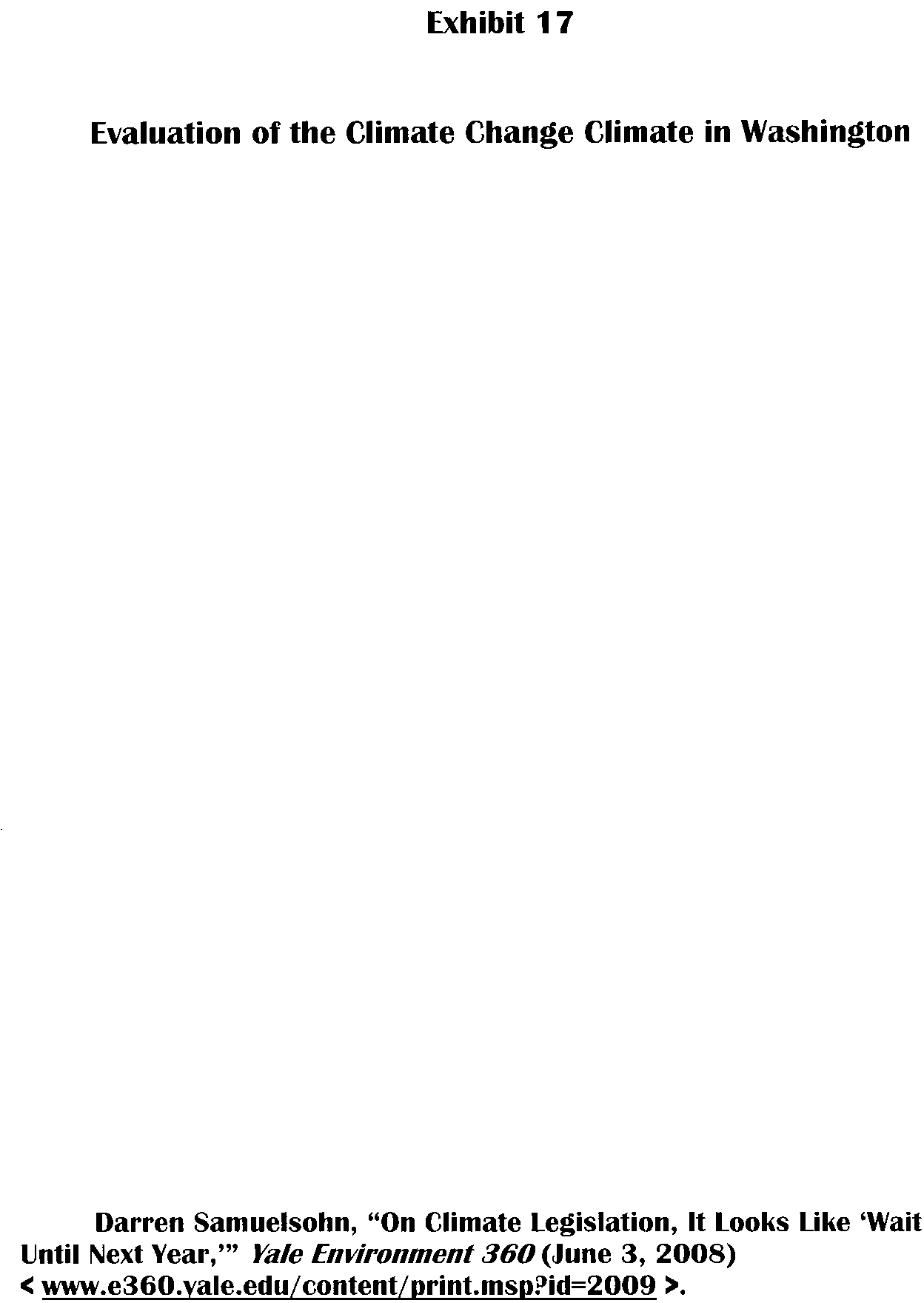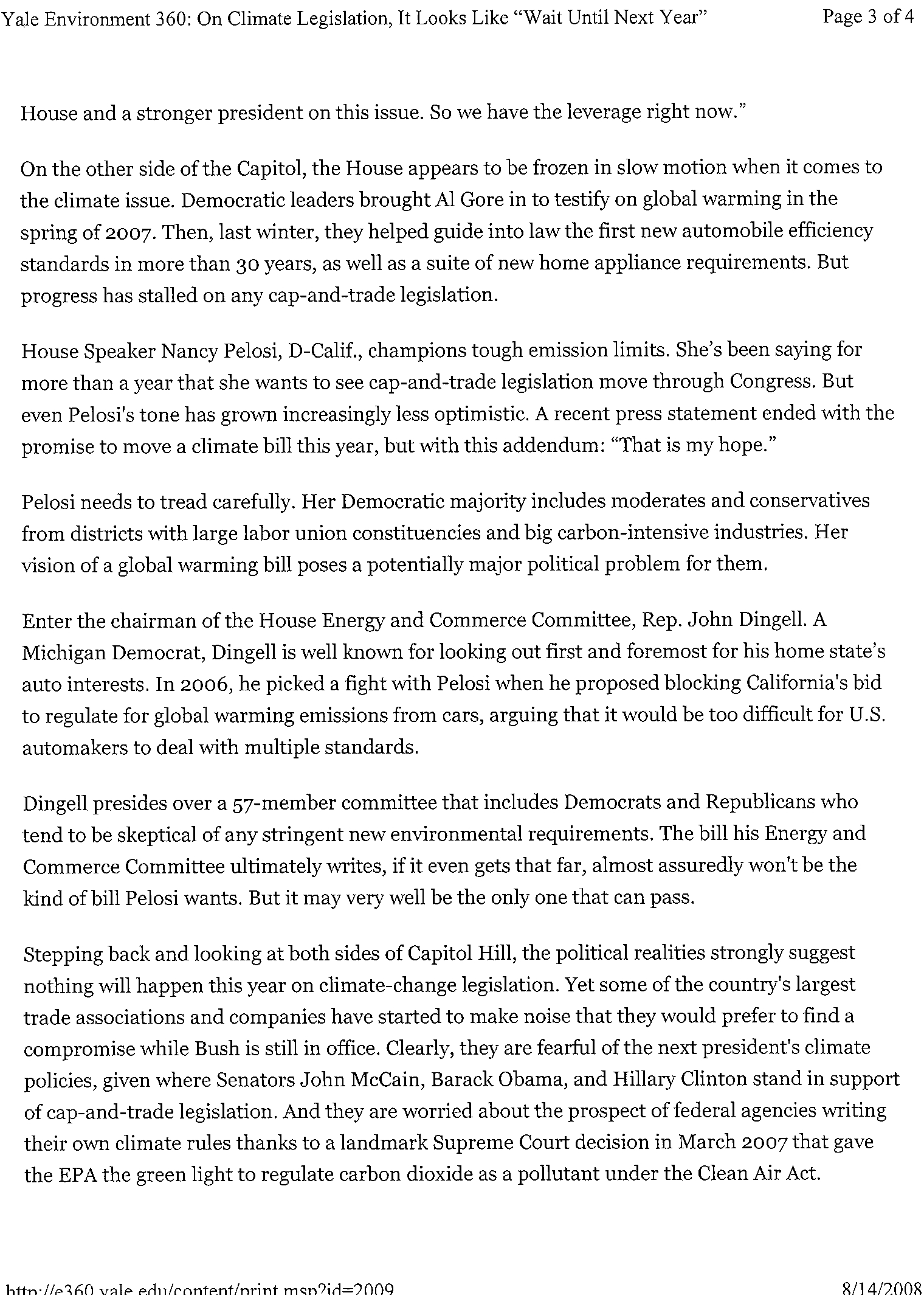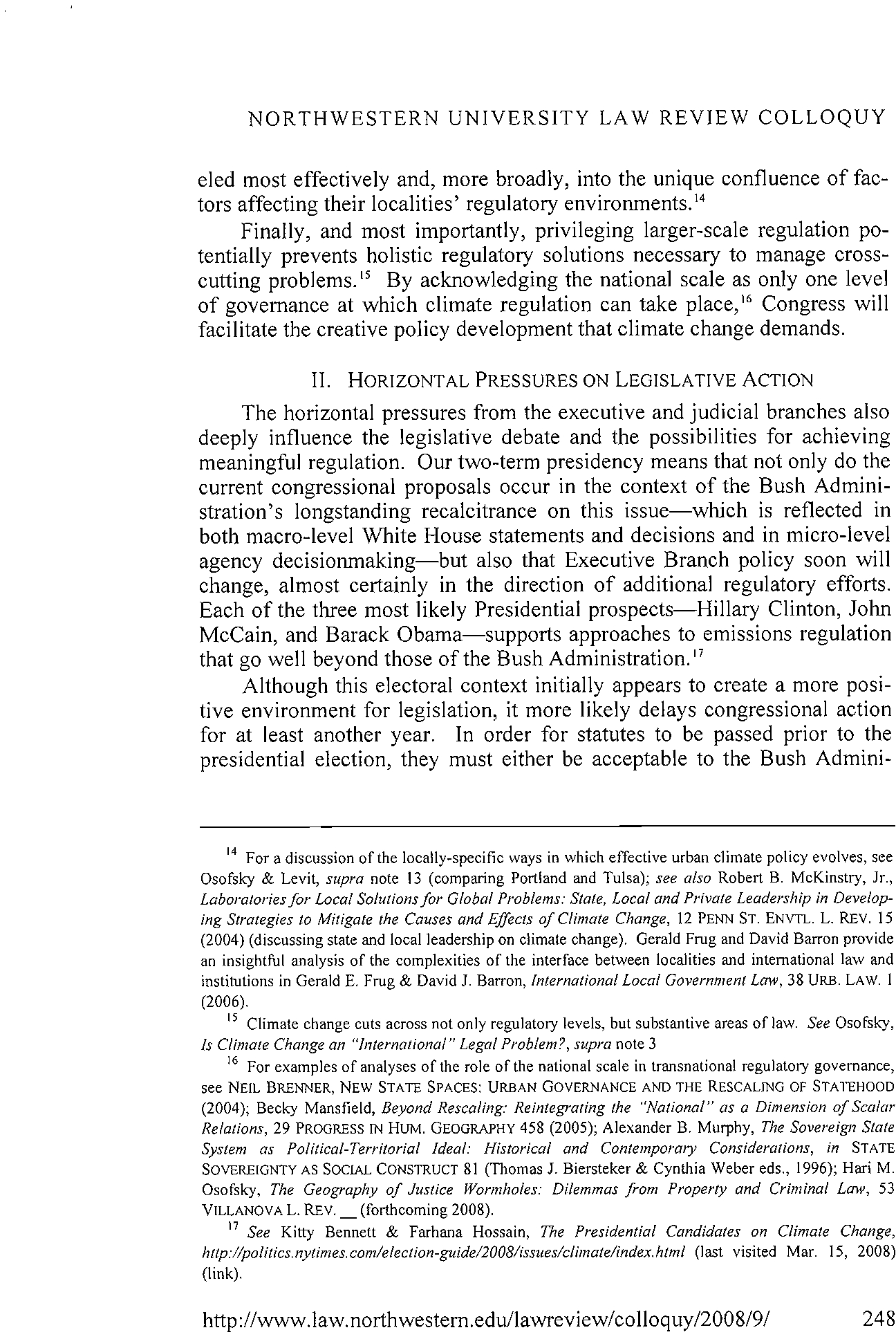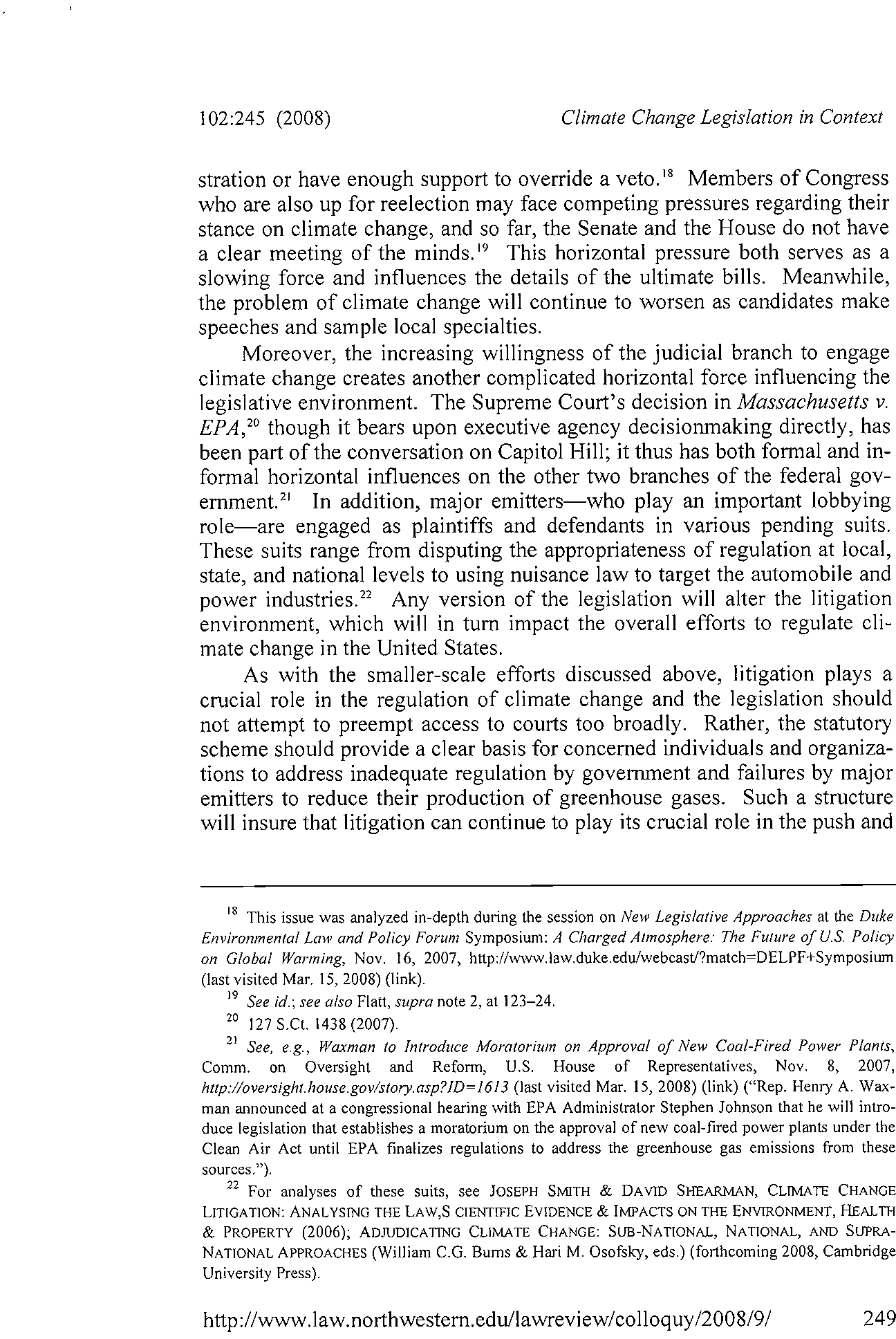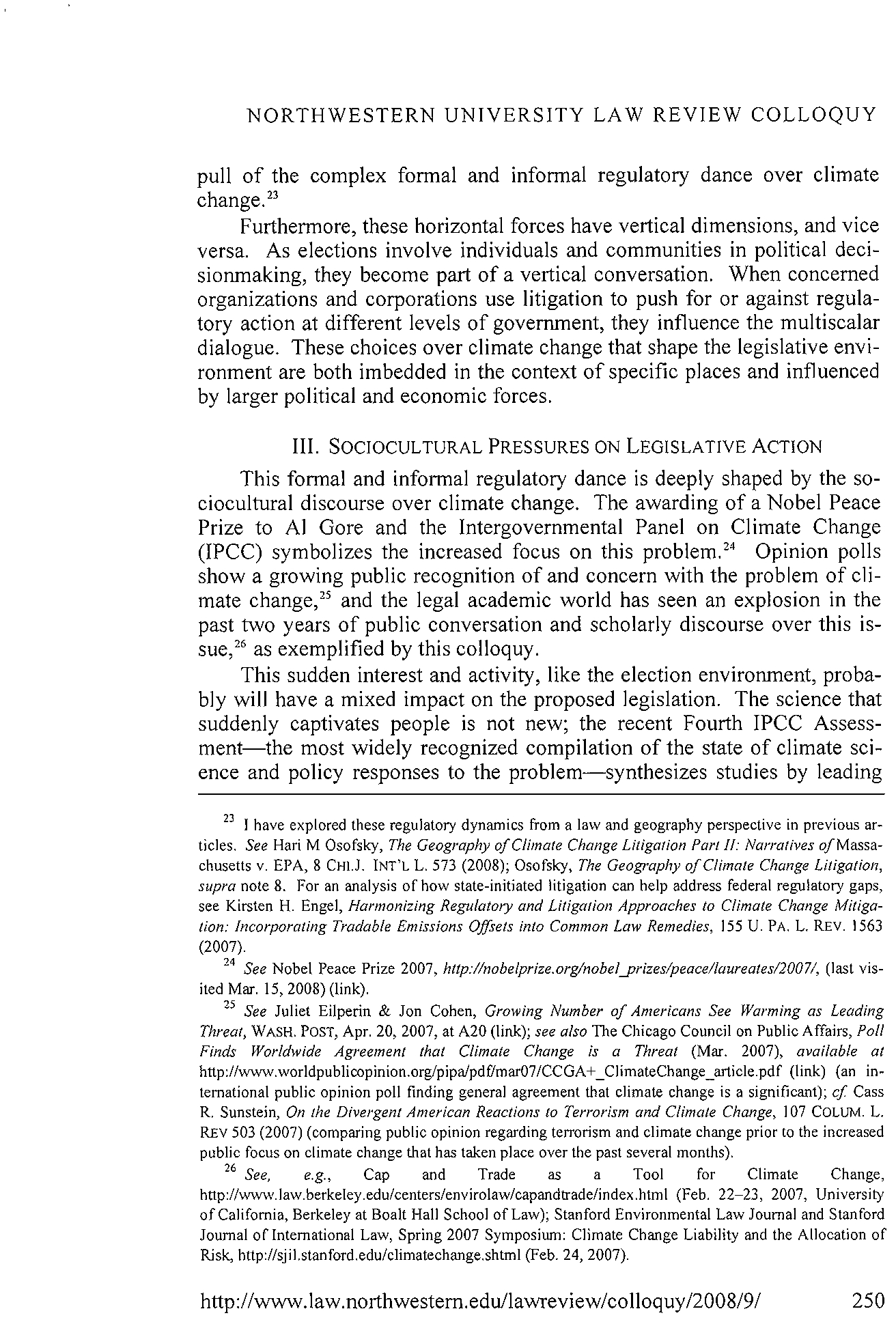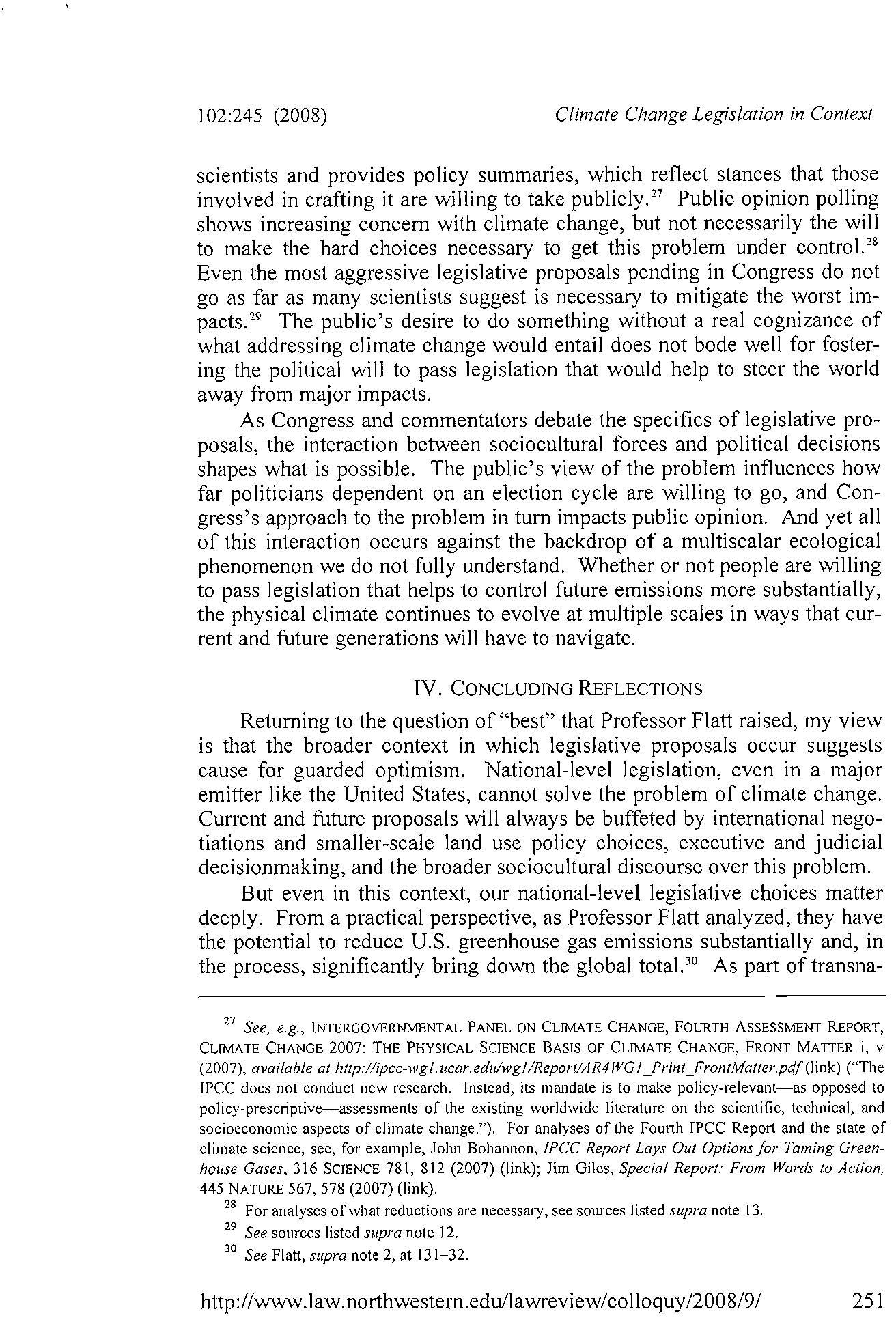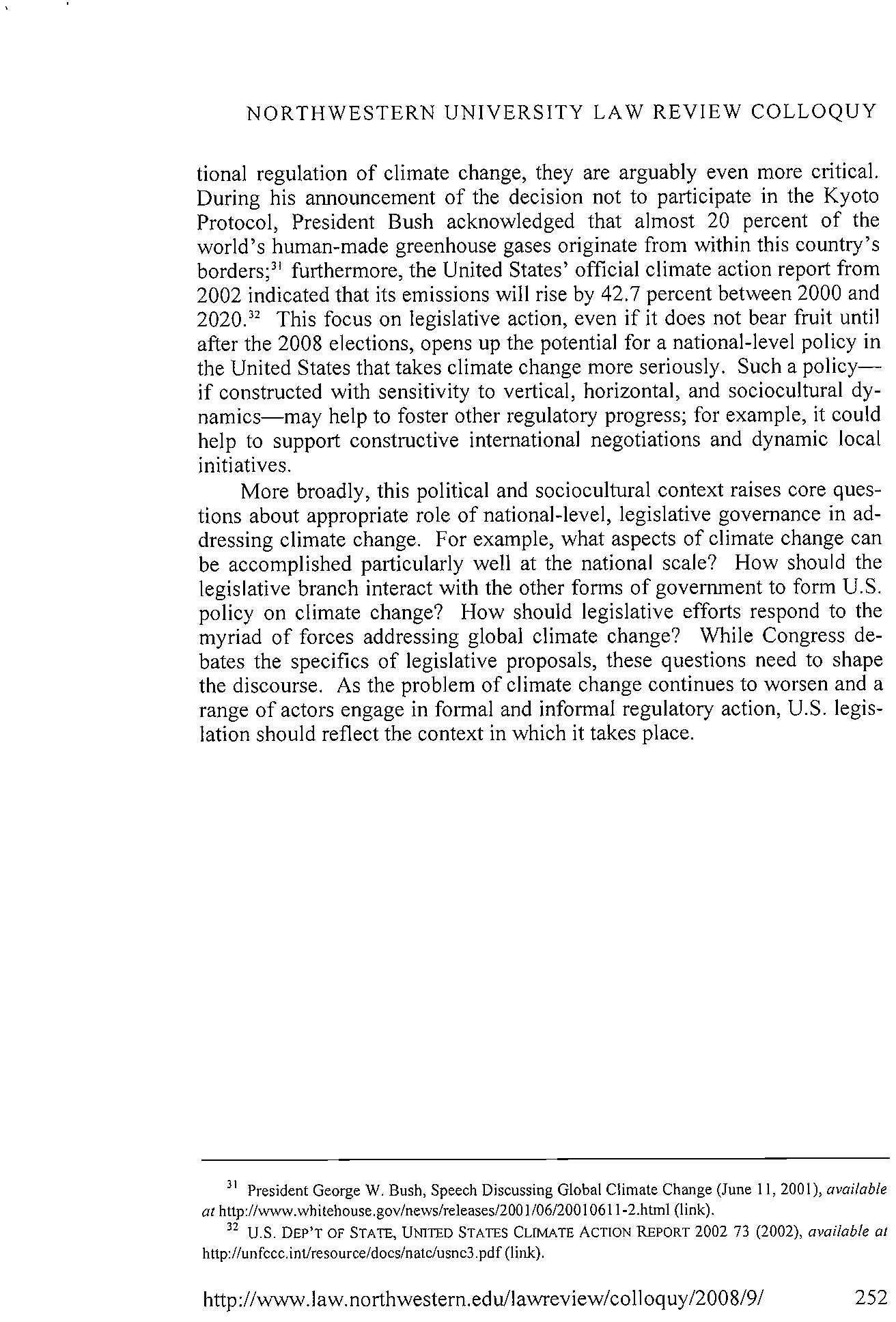Darren
Samuelsohn,
"On
Climate
Legislation,
It
Looks
Like
'Wait
Until
Next
Year,'"
Yale
Environment
360
(June
3,
2008)
<
www.e360.yale.edu/content/print.msp?id=2009
>.
Electronic Filing - Received, Clerk's Office, October 1, 2008
* * * * * PCB 2009-021 * * * * *
Until
N
ext
Year"
As
debate
begins
on
Capitol
Hill,
the
prospectsjor
passing
a
climate
change
bill
this
year
are
dimming.
Increasingly,
it
appears
as
though
any
new
law
will
await
a
new
Congress
and
a
new
president.
BY
DARREN
SAMUELSOHN
The
moderator
at
a
recent
climate
change
conference
asked
for
a
show
of
hands
on
who
thought
a
major
new
U.s.
global
warming
bill
would
pass
into
law
while
George
W.
Bush
was
still
in
office.
Of
about
150
people
in
the
room,
only
one
raised
his
hand.
"It's
my
job,"
Mark
MacLeod,
climate
campaign
coordinator
at
the
Environmental
Defense
Fund,
called
out,
as
he
explained
why
he
was
alone
in
thinking
that
2008
was
indeed
the
year
for
the
United
States
to
enact
its
first-ever
mandatory
limits
on
heat-trapping
greenhouse
gas
emissions.
Washington
is
a
city
of
full
of
speculation,
and
no
environmental
issue
has
gotten
the
prognosticators
going
quite
like
global
warming.
Expectations
for
a
major
U.s.
climate
change
law
have
been
building
ever
sinceDemocrats
woncontrol
of
Congress
in
2006.
And
Congress
has
tried
to
buckle
down
and
hash
through
the
preliminaries.
But
it's
a
long
way
from
there
to
a
bill-
signing
ceremony
with
President
Bush
holding
the
pen
-a
scenario
that
most
Washington
observers
now
consider
highly
unlikely.
To
date,
the
Senate
has
been
moving
the
quickest
in
getting
climate
legislation
to
the
floor.
Debate
on
a
bill
sponsored
by
Sen.
Joseph
Lieberman,
I-Conn.,
and
John
Warner,
R-Va.,
was
set
to
begin
this
week.
The
Lieberman-Warner
legislation
would
establish
a
mandatory
cap-and-trade
program
requiring
power
plants,
petroleum
refiners,
and
other
big
smokestack
industries
to
either
cut
their
own
emissions
or
buy
and
sell
credits
on
a
new
carbon
market
from
companies
that
do
clean
up
their
act.
Emissions
from
about
three-quarters
ofthe
U.S.
economy
would
be
covered
under
the
bill,
which
seeks
to
reduce
greenhouse
gas
levels
by
about
70
percent
from
2005
levels
by
httn.//p1h()
v:::t!p.
pnn/r()ntpnt/nrlnt
m<m?in=?OnQ
RI14/?OOR
Electronic Filing - Received, Clerk's Office, October 1, 2008
* * * * * PCB 2009-021 * * * * *
back
a
filibuster
and
pass
the
legislation.
But
that's
about
as
far
as
they're
willing
to
go
-
they're
making
no
assurances.
In
recent
months,
the
bill's
authors
have
been
trying
to
negotiate
on
several
potential
stumbling
blocks
-
each
dotted
with
its
own
potential
land
mines.
One
cluster
of
undecided
senators,
for
example,
wants
greater
incentives
for
nuclear
power.
Another
group
hopes
to
make
sure
any
U.S.
climate
policy
comes
with
a
corresponding
step
from
China
and
India.
It'll
require
a
delicate
balancing
act
to
get
to
60
votes.
"It's
like
a
game
oflegislative
Jenga,"
industry
lobbyist
Scott
Segal
said
as
the
authors
ofthe
Lieberman-Warner
bilI
guided
it
through
committee.
"Remove
one
piece
and
others
may
fall
out
of
place."
Boxer,
chairwoman
of
the
Senate
Environment
and
Public
Works
Committee,
holds
the
reins
over
any
legislation
that
will
go
to
a
floor
debate.
She
says
she
wants
to
toughen
the
bill,
but
that's
not
an
easy
task,
given
that
it
would
require
winning
over
moderate
and
conservative
Democrats
who
typically
don't
stand
for
strong
environmental
legislation.
Boxer
also
must
deal
with
a
group
of
mainly
Republican
senators,
from
Oklahoma's
James
Inhofe
to
Georgia's
Johnny
Isakson,
who
plan
to
offer
amendments
designed
to
make
the
Democrats
uncomfortable.
Picture
floor
speeches
on
how
much
the
legislation
will
cost
someone
trying
to
fill
up
their
gas
tank
in
Kansas
City
or
Phoenix.
With
the
prospects
of
a
floor
fight
looming,
Boxer
has
threatened
to
yank
the
Lieberman-Warner
bilI
off
the
agenda
and
wait
until
next
year
if
any
"weakening
amendments"
are
added.
Boxer
hasn't
said
exactly
what
a
weakening
amendment
would
be.
"You'll
know
it
when
you
see
it,"
she
told
reporters,
citing
the
Supreme
Court's
oft-quoted
definition
of
pornography.
Boxer
also
contends
that
she
will
be
able
to
count
on
more
votes
in
her
corner
after
the
2008
elections.
"I'm
willing
to
settle
for
the
necessary,
no
less,"
she
said.
"So
if
it
isn't
a
good
bilI,
it
isn't
going
to
happen.
We
think,
looking
ahead,
we're
going
to
have
a
stronger
Senate,
a
stronger
httn'//p1';()
,,~lp
,onll/rnntl::"nt/nr;nt
m<::n?ln=?()()Q
R/14/?OOR
Electronic Filing - Received, Clerk's Office, October 1, 2008
* * * * * PCB 2009-021 * * * * *
progress
has
stalled
on
any
cap-and-trade
legislation.
House
Speaker
Nancy
Pelosi,
D-Calif.,
champions
tough
emission
limits.
She's
been
saying
for
more
than
a
year
that
she
wants
to
see
cap-and-trade
legislation
move
through
Congress.
But
even
Pelosi's
tone
has
grown
increasingly
less
optimistic.
A
recent
press
statement
ended
with
the
promise
to
move
a
climate
bill
this
year,
but
with
this
addendum:
"That
is
my
hope."
Pelosi
needs
to
tread
carefully.
Her
Democratic
majority
includes
moderates
and
conservatives
from
districts
with
large
labor
union
constituencies
and
big
carbon-intensive
industries.
Her
vision
of
a
global
warming
bill
poses
a
potentially
major
political
problem
for
them.
Enter
the
chairman
of
the
House
Energy
and
Commerce
Committee,
Rep.
John
Dingell.
A
Michigan
Democrat,
Dingell
is
well
known
for
looking
out
first
and
foremost
for
his
home
state's
auto
interests.
In
2006,
he
picked
a
fight
with
Pelosi
when
he
proposed
blocking
California's
bid
to
regulate
for
global
warming
emissions
from
cars,
arguing
that
it
would
be
too
difficult
for
U.S.
automakers
to
deal
with
multiple
standards.
Dingell
presides
over
a
57-member
committee
that
includes
Democrats
and
Republicans
who
tend
to
be
skeptical
of
any
stringent
new
environmental
requirements.
The
bill
his
Energy
and
Commerce
Committee
ultimately
writes,
if
it
even
gets
that
far,
almost
assuredly
won't
be
the
kind
of
bill
Pelosi
wants.
But
it
may
very
well
be
the
only
one
that
can
pass.
Stepping
back
and
looking
at
both
sides
of
Capitol
Hill,
the
political
realities
strongly
suggest
nothing
will
happen
this
year
on
climate-change
legislation.
Yet
some
of
the
country's
largest
trade
associations
and
companies
have
started
to
make
noise
that
they
would
prefer
to
find
a
compromise
while
Bush
is
still
in
office.
Clearly,
they
are
fearful
of
the
next
president's
climate
policies,
given
where
Senators
John
McCain,
Barack
Obama,
and
Hillary
Clinton
stand
in
support
of
cap-and-trade
legislation.
And
they
are
worried
about
the
prospect
of
federal
agencies
writing
their
own
climate
rules
thanks
to
a
landmark
Supreme
Court
decision
in
March
2007
that
gave
the
EPA
the
green
light
to
regulate
carbon
dioxide
as
a
pollutant
under
the
Clean
Air
Act.
httn'//p1h()
v~lp
prhdrrmtpnt/nrint
m<;:.n?iri=?OOQ
RI14000R
Electronic Filing - Received, Clerk's Office, October 1, 2008
* * * * * PCB 2009-021 * * * * *
presidential
election
years
include
the
1972
Clean
Water
Act,
1992
Energy
Policy
Act,
and
the
2000
Everglades
Restoration
Act.
But
most
cooler
heads
see
time
ticking
away
on
this
year's
legislative
calendar.
If
anything,
2008
sounds
as
if
it
will
be
the
dress
rehearsal
for
the
next
Congress
and
the
next
president.
"Whatever
comes
to
the
[Senate]
floor
will
merely
be
for
the
purpose
of
fostering
debate,
not
for
passage,"
predicted
Sen.
Isakson,
R-Ga.,
who
opposes
the
Lieberman-Warner
bill
because
of
its
potential
economic
costs
and
also
because
he
wants
it
to
do
more
to
promote
expansion
of
nuclear
power.
"The
next
president
is
going
to
be
the
one
to
deal
with
it."
POSTED
ON
03
)UN
2008
IN
ABOUT
THE
AUTHOR
Darren
Samuelsohn
is
the
Washington,
D.C.,
correspondent
for
Yale
Environment
360.
He
also
covers
global
warming
policy
and
politics
for
Greenwire
and
Environment
&
Energy
Daily.
©
2008
Yale
Environment
360
httn"
I
If>.
inO.
V"
le.enu/content/nri
nt.
msn?i
d=2009
8/14/2008
Electronic Filing - Received, Clerk's Office, October 1, 2008
* * * * * PCB 2009-021 * * * * *
"lieberman-Warner
Bill,
Boxer
Amendment
(S.
3036),"
<
www.uschamber.com/issues/index/
environment/080603climatechange.
htm
>.
Electronic Filing - Received, Clerk's Office, October 1, 2008
* * * * * PCB 2009-021 * * * * *
BILL,
BOXER
AMEND
REGULATIQ
The
Boxer
Amendment
to
the
lieberman-Womer
CIina1B
security
Act
of
2008
(8.3038)
oonlains
over
300
regulations
and
mandalas.
Each
regulation
must
go
through
the
Regulatory
Process
detailed
in
the
center
01
the
char\.
Electronic Filing - Received, Clerk's Office, October 1, 2008
* * * * * PCB 2009-021 * * * * *
Hari
M.
Osofsky,
"Climate
Change
legislation
in
Context,"
Northwestern
IJnit'ersity
Law
Ret'iew
Colloquy,
102
(2008):
245-252
<
www.law.norlhwestern.edu/lawreview/colloguy/2008/9/
>.
Electronic Filing - Received, Clerk's Office, October 1, 2008
* * * * * PCB 2009-021 * * * * *
Hari
M
Gsa/sky'
Congress
is
finally
taking
climate
change
seriously,
or
at
the
very
least
is
engaged
in
a
flurry
of
activity
regarding
greenhouse
gas
emissions.
The
Lieberman-
Warner
Climate
Security
Act
made
it
out
of
the
Senate
Envi-
ronment
and
Public
Works
Committee,
and
vigorous
debates
are
taking
place
over
the
appropriate
regulatory
approach
to
climate
change
and
en-
ergy.1
This
Essay
considers
the
context
of
that
statutory
conversation.
Namely,
how
does
the
possibility
of
U.S.
legislative
action
fit
within
a
broader
picture
of
transnational
climate
change
governance?
Professor
Victor
Flatt's
lead
piece
on
climate
change
legislation
in
this
colloquy
provides
a
thoughtful
analysis
of
the
many
pending
federal
climate
change
legislative
proposals,
including
his
assessment
of
what
is
"best."
He
provides
a
detailed
description
of
the
pending
proposals,
as
well
as
a
nor-
mative
discussion
of
legislative
goals
and
means
of
attaining
them.
In
the
course
of
his
analysis,
he
references
both
international
negotiations
and
smaller
scale
regulation.
He
indicates
that
U.S.
legislation
should
be
devel-
oped
in
a
way
that
would
be
compatible
with-but
not
wait
for-possible
future
international
agreements
and
also
not
block
smaller-scale
efforts.
2
This
Essay
builds
upon
Professor
Flatt's
thoughtful
analysis
of
the
pending
legislation
by
putting
it
in
the
broader
context
of
developments
re-
garding
climate
change.
In
contrast
to
Professor
Flatt's
emphasis
on
spe-
cific
legislative
proposals,
this
Essay
provides
a
contextualized,
normative
analysis.
In
particular,
I
focus
on
three
main
types
of
pressures
on
the
legis-
lation.
First,
the
legislation
faces
vertical
pressures
from
"above"
(interna-
Assistant
Professor,
University
of
Oregon
School
of
Law
(2006-08);
Associate
Professor,
Wash-
ington
and
Lee
University
School
of
Law
(beginning
Fall
2008);
B.A
..
J.D.,
Yale
University.
This
Commentary
has
been
greatly
improved
through
insightful
feedback
from
Mark
Drumbl,
Frank
Pin.
ciotta,
and
the
Fall
2007
Political
Ecology
seminar
taught
by
Professor
Peter
Walker
at
the
University
of
Oregon,
and
has
been
deeply
influenced
by
conversations
at
the
recent
2007
Duke
Environmental
Law
and
Policy
Forum
Symposium.
I
also
am
grateful
for
the
thoughtful
editing
of
Jason
Allen,
Kristin
Feeley,
Brianne
Straka,
and
Isaac
Peterson
of
the
Northwestern
University
Law
Revie.lII.
As
always,
1
tremendously
appreciate
the
loving
support
of
Joshua
and
Oz
Gitelson.
I
See
Press
Release,
U.S.
Senate
Comm.
on
Env't
and
Pub.
Works,
Boxer
says
Passage
of
Historic
Global
Wanning
Bill
"Puts
the
Wind
at
Our
Backs"
(Dec.
5,
200?),
available
at
hup://epw.senate.gov/pllhlidindex.cfin?FuseAction=PressRoom.PressReleases&ContenIRecord_id=AC
F879BO-802A-23AD-49C5-7B9/482C
I
DD
/
(link).
2
See
Victor
B.
Flatt,
Taking
Ihe
Legislative
Temperature:
Which
Legislative
Proposal
is
"Besl"?,
102
Nw.
U.
L.
REv.
COLLOQUY
123
(2007),
hup://colloqlly./mv.norilnvestern.edu/main/2007//2/taking.
Ihe-Iegi.hlml
(link).
245
Electronic Filing - Received, Clerk's Office, October 1, 2008
* * * * * PCB 2009-021 * * * * *
legislation
are
simultaneously
horizontal
and
vertical,
such
as
when
states
and
cities
use
federal
courts
to
push
executive
branch
agencies
to
regulate.
J
Finally,
and
perhaps
most
importantly
given
the
looming
Presidential
elec-
tion,
the
shifting
public
awareness
of
climate
change
creates
an
impetus
for
Congress
to
take
meaningful
action
or
at
least
to
appear
to
do
so.
Together,
these
interactions
imbue
this
legislation
with
significance
beyond
the
specifics
of
its
direct
impacts.
Namely,
the
potential
legislation
forms
part
of
a
broader,
complex
regulatory
map.
The
viability
and
impact
of
legislative
proposals
depend
on
how
a
range
of
other
people
and
entities
behave,
and
in
turn,
the
proposals
influence
their
behavior.
In
so
doing,
the
legislation
can
serve
in
not
only
a
norm-implementing
role,
but
also
norm-
generating
one.
4
Through
exploring
the
context
of
climate
change
legisla-
tion,
this
Essay
thus
argues
for
an
integrated
approach
to
transnational
cli-
mate
regulation.
I.
VERTICAL
PRESSURES
ON
LEGISLATIVE
ACTION
Professor
Flatt
provides
a
version
of
"best"
that
allows
legislative
ef-
forts
to
move
forward
in
tandem
with
initiatives
at
other
levels
of
govern-
ance.
He
explains
that
the
statutory
regime
should
neither
wait
for
agreement
on
the
2012
replacement
for
the
Kyoto
Protocol
nor
develop
in
a
way
that
would
be
incompatible
with
its
likely
targets.'
Similarly,
Flatt
ac-
knowledges
the
importance
of
subnational
efforts
on
climate
change,
and
urges
that
thelegislation
not
be
structured
in
a
manner
that
preempts
those
innovative
efforts.
6
I
agree
with
Professor
Flatt's
analysis,
but
would
like
to
develop
it
fur-
ther
through
reference
to
geography'
and,
more
specifically,
to
issues
of
3
I
term
these
simultaneous
horizontal
and
vertical
interactions
"diagonal"
in
a
draft.
article
on
the
appropriate
scale
of
climate
regulation.
See
Han
M.
Osofsky,
/s
Climate
Change
an
"International"
Legal
Problem?:
Towards
Diagonal
Regulatory
Strategies
(draft
manuscript
on
file
with
author)
[here-
inafter
Osofsky,
/s
Climate
Change
an
"International"
Legal
Problem?].
For
an
in-depth
analysis
of
"horizontal"
and
"vertical"
interactions
as
part
of
transgovemmental
decisionmaking,
see
ANNE-MARIE
SLAUGHTER,
A
NEW
WORLD
ORDER
(2004).
"
For
an
interesting
analysis
of
the
expressivist
function
of
lawmaking-its
role
in
social
nonn
gen-
eration-in
the
criminal
law
context,
see
MARK
A.
DRUMBL,
ATROCITY,
PUNlSHMENT,
AND
INTERNATIONAL
LAW
173
(2007).
5
See
Flatt,
supra
note
2,
at
131-32.
6
See
id.
at
134.
7
Geography
is
a
discipline
that
studies
the
interrelationship
of
place,
space,
and
scale
over
time.
Geography's
inclusion
of
both
the
hard
and
social
sciences
has
been
a
source
of
both
strength
and
weak-
http://www.law.northwestern.edu/lawreview/colloquy/2008/9/
246
Electronic Filing - Received, Clerk's Office, October 1, 2008
* * * * * PCB 2009-021 * * * * *
vertical
pressures
because
the
problem
cannot
be
regulated
at
only
one
level
of
governance,
even
a
very
powerful
national
one.'
Although
there
has
been
broad
acknowledgment
across
the
political
spectrum
of
the
value
of
addressing
climate
change
at
a
global
scale,
more
skepticism
exists
about
state
and
local
initiatives.
Some
argue
that
the
problem
is
too
large
both
spatially
and
temporally
to
manage
at
smaller
lev-
els
of
governance.
10
These
types
of
anti
regulatory
arguments
are
potentially
dangerous,
whether
made
in
the
context
of
legislation
or
litigation
for
three
primary
reasons."
First,
neither
international
nor
national
efforts
seem
likely
to
go
far
enough
to
get
this
problem
under
control,12
so
smaller
scale
efforts
are
needed
to
spur
innovation
and
action."
If
the
legislation
blocks
these
ef-
forts,
greater
emissions,
with
their
troubling
consequences,
may
result.
Second,
however
the
balance
between
centralization
and
decentraliza-
tion
of
goverrunental
power
is
struck
in
this
area
of
law,
effective
climate
policy
should
provide
opportunities
to
draw
from
state
and
local
expertise
and
core
competences.
City
governments,
for
example,
will
have
insights
into
how
streets
should
be
organized
in
order
to
decrease
vehicle
miles
trav-
ness
for
that
discipline
in
the
U.S.
academy.
See
Alexander
B.
Murphy,
Geography's
Place
in
Higher
Education
in
the
United
Stales,
31
J.
GEOGRAPHY
IN
HIGHER
EDUC.
121,
122-23
(2007).
8
See
Osofsky,/s
Climate
Change
an
"International"
Legal
Problem?,
supra
note
3;
see
also
Hari
M.
Osofsky,
The
Geography
o/Climate
Change
Litigation:
Implications/or
Transnational
Regulatory
Governance,
83
WASH.
U.
L.Q.
1789
(2005)
[hereinafter
Osofsky,
The
Geography
a/Climate
Change
Litigation].
For
a
comparative
analysis
of
the
concept
of
scale
in
the
geography
and
political
ecology
literatures,
see
Nathan
F.
Sayre,
Ecological
and
Geographical
Scale:
Parallels
and
Potential
for
Inte-
gration,
29
PR<X1RESS
IN
HUM.
GEOGRAPHY
276
(2005).
9
See
Osofsky,
Is
Climate
Change
an
"International"
Legal
Problem?,
supra
note
3.
10
See,
e.g.,
Jonathan
B.
Wiener,
Think
Globally,
Act
Globally:
The
Limits
of
Local
Climate
Poli-
cies,
155
U.
PENN.
L.
REv.
1961,
1962
(2007)
{arguing
that
"subnational
state-level
action
is
not
the
best
way
to
combat
global
climate
change"}.
II
My
new
draft
article
explores
these
concerns,
addressed
briefly
below,
in
more
depth.
See
Osof-
sky,
Is
Climate
Change
an
"Imernotiona/"
Legal
Problem?,
supra
note
3.
12
See
H-Holger
Rogner,
et
ai,
Introduction
to
INTERGOVERNMENTAL
PANEL
ON
CLIMATE
CHANGE,
FOURTH
ASSESSMENT
REPORT,
CLIMATE
CHANGE
200?:
MITIGATION
95,
109-12
(B.
Metz
et
al
eds.,
200?),
available
at
http://www.ipcc.chlpdf/assessmenl-reportlar4/wg3/ar4-wg3-chapterl.pdf.
1J
For
examples
of
some
recent
analyses
of
the
benefits
and
limitations
of
state
and
local
climate
initiatives,
see
Randall
S.
Abate,
Kyoto
or
Not,
Here
We
Come:
The
Promise
and
Perils
of
the
Piece-
meal
Approach
to
Climate
Change
Regulation
in
the
UnitedStates,
15
CORNELL
lL.
&
PUB.
POL'y
369
(2006);
Hari
M.
Osofsky
&
Janet
Koven
Levit,
The
Scale
of
Networks:
Local
Climate
Change
Coali-
tions,
8
CHI.
J.INT'L
L.
409
(2008);
Wiener,
supra
note
10.
http://www.iaw.northwestern.edu/lawreview/colloquy/2008/9/
247
Electronic Filing - Received, Clerk's Office, October 1, 2008
* * * * * PCB 2009-021 * * * * *
of
governance
at
which
climate
regulation
can
take
place,16
Congress
will
facilitate
the
creative
policy
development
that
climate
change
demands.
II.
HORIZONTAL
PRESSURES
ON
LEGISLATIVE
ACTION
The
horizontal
pressures
from
the
executive
and
judicial
branches
also
deeply
influence
the
legislative
debate
and
the
possibilities
for
achieving
meaningful
regulation.
Our
two-term
presidency
means
that
not
only
do
the
current
congressional
proposals
occur
in
the
context
of
the
Bush
Admini-
stration's
longstanding
recalcitrance
on
this
issue-which
is
reflected
in
both
macro-level
White
House
statements
and
decisions
and
in
micro-level
agency
decisionmaking-but
also
that
Executive
Branch
policy
soon
will
change,
almost
certainly
in
the
direction
of
additional
regulatory
efforts.
Each
of
the
three
most
likely
Presidential
prospects-Hillary
Clinton,
John
McCain,
and
Barack
Obama-supports
approaches
to
emissions
regulation
that
go
well
beyond
those
of
the
Bush
Administration.
17
Although
this
electoral
context
initially
appears
to
create
a
more
posi-
tive
environment
for
legislation,
it
more
likely
delays
congressional
action
for
at
least
another
year.
In
order
forstatutes
to
be
passed
prior
to
the
presidential
election,
they
must
either
be
acceptable
to
the
Bush
Admini-
14
For
a
discussion
of
the
locally-specific
ways
in
which
effective
urban
climate
policy
evolves,
see
Osofsky
&
Levit,
supra
note
13
(comparing
Portland
and
Tulsa);
see
also
Robert
B.
McKinstry,
Jr.,
Laboratories
for
Local
Solutions
for
Global
Problems:
State,
Local
and
Private
Leadership
in
Develop-
ing
Strategies
to
Mitigate
the
Causes
and
Effecls
o/Climate
Change,
12
PENN
ST.
ENVTL
L.
REv.
15
(2004)
(discussing
state
and
local
leadership
on
climate
change).
Gerald
Frug
and
David
Barron
provide
an
insightful
analysis
of
the
complexities
of
the
interface
bet"veen
localities
and
international
law
and
institutions
in
Gerald
E.
Frug
&
David
1.
Barron,
International
Local
Government
Lmy,
38
URB.
LAW.
I
(2006).
IS
Climate
change
cuts
across
not
only
regulatory
levels,
but
substantive
areas
of
law.
See
Osofsky.
Is
Climate
Change
an
"International"
Legal
Problem?,
supra
note
3
16
For
examples
of
analyses
of
the
role
of
the
national
scale
in
transnational
regulatory
governance,
see
NEIL
BRENNER,
NEW
STATE
SPACES:
URBAN
GOVERNANCE
AND
THE
RESCALING
OF
STATEHOOD
(2004);
Becky
Mansfield,
Beyond
Rescaling:
Reintegrating
the
"National"
as
a
Dimension
0/
Scalar
Relations,
29
PROORESS
IN
HUM.
GEOGRAPHY
458
(2005);
Alexander
B.
Murphy,
The
Sovereign
State
System
as
Political-Territorial
/deal:
Historical
and
Contemporary
Considerations,
in
STATE
SOVEREIGNTY
AS
SOClAL
CONSTRUCT
81
(Thomas
J.
Biersteker
&
Cynthia
Weber
eds.,
1996);
Hari
M.
Osofsky,
The
Geography
0/
Justice
Wormholes:
Dilemmas
from
Property
and
Criminal
Lmy,
53
VILLANOVA
L.
REv.
_
(forthcoming
2008).
17
See
Kitty
Bennett
&
Farhana
Hossain,
The
Presidential
Candidates
on
Climate
Change,
h/tp://politics.nytimes.com/election.guide/2008/issues/c1imate/index.
html
(last
visited
Mar.
IS,
2008)
(link).
http://www.law.northwestern.edu/lawreview/colloquy/2008/9/
248
Electronic Filing - Received, Clerk's Office, October 1, 2008
* * * * * PCB 2009-021 * * * * *
the
problem
of
climate
change
will
continue
to
worsen
as
candidates
make
speeches
and
sample
local
specialties.
Moreover,
the
increasing
willingness
of
the
judicial
branch
to
engage
climate
change
creates
another
complicated
horizontal
force
influencing
the
legislative
environment.The
Supreme
Court's
decision
in
Massachusetts
v.
EPA,'.
though
it
bears
upon
executive
agency
decisionmaking
directly,
has
been
part
of
the
conversation
on
Capitol
Hill;
it
thus
has
both
formal
and
in-
formal
horizontal
influences
on
the
other
two
branches
of
the
federal
gov-
ernment."
In
addition,
major
emitters-who
play
an
important
lobbying
role-are
engaged
as
plaintiffs
and
defendants
in
various
pending
suits.
These
suits
range
from
disputing
the
appropriateness
of
regulation
at
local,
state,
and
national
levels
to
using
nuisance
law
to
target
the
automobile
and
power
industries.
22
Any
version
of
the
legislation
will
alter
the
litigation
environment,
which
will
in
turn
impact
the
overall
efforts
to
regulate
cli-
mate
change
in
the
United
States.
As
with
the
smaller-scale
efforts
discussed
above,
litigation
plays
a
crucial
role
in
the
regulation
of
climate
change
and
the
legislation
should
not
attempt
to
preempt
access
to
courts
too
broadly.
Rather,
the
statutory
scheme
should
provide
a
clear
basis
for
concerned
individuals
and
organiza-
tions
to
address
inadequate
regulation
by
government
and
failures
by
major
emitters
to
reduce
their
production
of
greenhouse
gases.
Such
a
structure
will
insure
that
litigation
can
continue
to
play
its
crucial
role
in
the
push
and
18
This
issue
was
analyzed
in-depth
during
the
session
on
New
Legislative
Approaches
at
the
Duke
Environmental
Law
and
Policy
Forum
Symposium:
A
Charged
Atmosphere:
The
FUlure
of
u.s.
Policy
on
Global
Warming,
Nov.
16,
2007,
http://www.law.duke.edulwebcastl?match=DELPF+Symposium
(last
visited
Mar.
15,
2008)
(link).
19
See
id.;
see
also
Flatt,
supra
note
2,
at
123-24.
2.
127
S.C!.
1438
(2007).
21
See.
e.g.,
Waxman
to
Introduce
Moratorium
on
Approval
of
New
Coal-Fired
Power
Plants,
Camm.
on
Oversight
and
Refonn,
U.S.
House
of
Representatives,
Nov.
8,
2007.
hllp://oversighl.hollse.gov/slory.asp?/D=/6/3
(last
visited
Mar.
15,2008)
(link)
("Rep.
Henry
A.
Wax.
man
announced
at
a
congressional
hearing
with
EPA
Administrator
Stephen
Johnson
that
he
will
intro.
duce
legislation
that
establishes
a
moratorium
on
the
approval
of
new
coal.
fired
power
plants
under
the
Clean
Air
Act
until
EPA
finalizes
regulations
to
address
the
greenhouse
gas
emissions
from
these
sources.").
22
For
analyses
of
these
suits,
see
JOSEPH
SMITH
&
DAVID
SHEARMAN,
CLIMATE
CHANGE
LITIGATION:
ANALYSING
THE
LAW,S
CIENTIFIC
EVIDENCE
&
IMPACTS
ON
THE
ENVIRONMENT,
HEALTH
&
PROPERTY
(2006);
ADJUDICATING
CLIMATE
CHANGE:
SUB.NATIONAL,
NATIONAL,
AND
SUPRA-
NATIONAL
ApPROACHES
(William
C.G.
Bums
&
Hari
M.
Osofsky,
eds.)
(forthcoming
2008,
Cambridge
University
Press).
http://www.law.northwestern.edu/lawreview/colloquy/2008/9/
249
Electronic Filing - Received, Clerk's Office, October 1, 2008
* * * * * PCB 2009-021 * * * * *
organizations
and
corporations
use
litigation
to
push
for
or
against
regula-
tory
action
at
different
levels
of
government,
they
influence
the
multiscalar
dialogue.
These
choices
over
climate
change
that
shape
the
legislative
envi-
ronment
are
both
imbedded
in
the
context
of
specific
places
and
influenced
by
larger
political
and
economic
forces.
III.
SOCIOCULTURAL
PRESSURES
ON
LEGIS
LA
TIVE
ACTION
This
formal
and
informal
regulatory
dance
is
deeply
shaped
by
the
so-
ciocultural
discourse
over
climate
change.
The
awarding
of
a
Nobel
Peace
Prize
to
Al
Gore
and
the
Intergovernmental
Panel
on
Climate
Change
(lPCC)
symbolizes
the
increased
focus
on
this
problem."
Opinion
polls
show
a
growing
public
recognition
of
and
concern
with
the
problem
of
cli-
mate
change,25
and
the
legal
academic
world
has
seen
an
explosion
in
the
past
two
years
of
public
conversation
and
scholarly
discourse
over
this
is-
sue,26
as
exemplified
by
this
colloquy.
This
sudden
interest
and
activity,
like
the
election
environment,proba-
bly
will
have
a
mixed
impact
on
the
proposed
legislation.
The
science
that
suddenly
captivates
people
is
not
new;
the
recent
Fourth
IPCC
Assess-
ment-the
most
widely
recognized
compilation
of
the
state
of
climate
sci-
ence
and
policy
responses
to
the
problem-synthesizes
studies
by
leading
23
I
have
explored
these
regulatory
dynamics
from
a
law
and
geography
perspective
in
previous
ar-
ticles.
See
Hari
M
Osofsky,
The
Geography
o/Climate
Change
Litigation
Part
II:
Narratives
a/Massa-
chusetts
v.
EPA,
8
CHi.J.
INT'L
L.
573
(2008);
Osofsky,
The
Geography
a/Climate
Change
Litigation,
supra
note
8.
For
an
analysis
of
how
state~iniljated
litigation
can
help
address
federal
regulatory
gaps,
see
Kirsten
H.
Engel,
Harmonizing
Regula/my
and
Litigation
Approaches
to
Climate
Change
Mitiga-
tion:
Incorporating
Tradable
Emissions
Offsets
into
Common
Law
Remedies,
155
U.
PA.
L.
REV.
1563
(2007).
24
See
Nobel
Peace
Prize
2007,
http://nobeJprize.org/nobelyrizes/peace/laureates/2007/,
(last
vis-
ited
Mar.
15,2008)
(link).
25
See
Juliet
Eilperin
&
Jon
Cohen,
Growing
Number
of
Americans
See
Warming
as
Leading
Threat,
WASH.
POST,
Apr.
20,
2007,
at
A20
(link);
see
also
The
Chicago
Council
on
Public
Affairs,
Poll
Finds
Worldwide
Agreement
that
Climate
Change
is
a
Threat
(Mar.
2007),
available
at
http://www.worldpublicopinion.org/pipalpdf/mar07/CCGA+
_
ClimateChange
_article.
pdf
(link)
(an
in-
ternational
public
opinion
poll
finding
general
agreement
that
climate
change
is
a
significant);
c/
Cass
R.
Sunstein,
On
the
Divergent
American
Reactions
to
Terrorism
and
Climate
Change,
107
COLUM.
L.
REv
503
(2007)
(comparing
public
opinion
regarding
terrorism
and
climate
change
prior
to
the
increased
public
focus
on
climate
change
that
has
taken
place
over
the
past
several
months).
26
See,
e.g.,
Cap
and
Trade
as
a
Tool
for
Climate
Change,
http://www.law.berkeley.edu/centers/envirolaw/capandtrade/index.html(Feb.
22-23,
2007,
University
of
California,
Berkeley
at
Boalt
Hall
School
of
Law);
Stanford
Environmental
Law
Journal
and
Stanford
Journal
of
International
Law,
Spring
2007
Symposiwn:
Climate
Change
Liability
and
the
Allocation
of
Risk,
http://sjil.stanford.edu/climatechange.shtml
(Feb.
24,
2007).
http://www.law.northwestern.eduiJawreview/colloquy/2008/9/
250
Electronic Filing - Received, Clerk's Office, October 1, 2008
* * * * * PCB 2009-021 * * * * *
go
as
far
as
many
scientists
suggest
is
necessary
to
mitigate
the
worst
im-
pacts.
29
The
public's
desire
to
do
something
without
a
real
cognizance
of
what
addressing
climate
change
would
entail
does
not
bode
well
for
foster-
ing
the
political
will
to
pass
legislation
that
would
help
to
steer
the
world
away
from
major
impacts.
As
Congress
and
commentators
debate
the
specifics
of
legislative
pro-
posals,
the
interaction
between
sociocultural
forces
and
political
decisions
shapes
what
is
possible.
The
public's
view
of
the
problem
influences
how
far
politicians
dependent
on
an
election
cycle
are
willing
to
go,
and
Con-
gress's
approach
to
the
problem
in
tum
impacts
public
opinion.
And
yet
all
of
this
interaction
occurs
against
the
backdrop
of
a
multi
scalar
ecological
phenomenon
we
do
not
fully
understand.
Whether
or
not
people
are
willing
to
pass
legislation
that
helps
to
control
future
emissions
more
substantially,
the
physical
climate
continues
to
evolve
at
multiple
scales
in
ways
that
cur-
rent
and
future
generations
will
have
to
navigate.
IV.
CONCLUDING
REFLECTIONS
Returning
to
the
question
of
"best"
that
Professor
Flatt
raised,
my
view
is
that
the
broader
context
in
which
legislative
proposals
occur
suggests
cause
for
guarded
optimism.
National-level
legislation,
even
in
a
major
emitter
like
the
United
States,
cannot
solve
the
problem
of
climate
change.
Current
and
future
proposals
will
always
be
buffeted
by
international
nego-
tiations
and
smaller-scale
land
use
policy
choices,
executive
and
judicial
decisionmaking,
and
the
broader
sociocultural
discourse
over
this
problem.
But
even
in
this
context,
our
national-level
legislative
choices
matter
deeply.
From
a
practical
perspective,
as
Professor
Flattanalyzed,
they
have
the
potential
to
reduce
U.S.
greenhouse
gas
emissions
substantially
and,
in
the
process,
significantly
bring
down
the
global
total.
JO
As
part
of
transna-
27
See,
e.g.,
INTERGOVERNMENTAL
PANEL
ON
CLIMATE
CHANGE,
FOURTH
ASSESSMENT
REPORT,
CLIMATE
CHANGE
2007:
THE
PHYSICAL
SCIENCE
BASIS
OF
CLIMATE
CHANGE,
FRONT
MATIER
i,
v
(2007),
available
at
http://ipcc-wgl.ucar.edu/wgJ/Report/AR4WG
J
~Print_FrontMatter.pdf(link)
("The
IPee
does
not
conduct
new
research.
Instead,
its
mandate
is
to
make
policy-relevant-as
opposed
to
policy-prescriptive-assessments
of
the
existing
worldwide
literature
on
the
scientific,
technical,
and
socioeconomic
aspects
of
climate
change.").
For
analyses
of
the
Fourth
fPee
Report
and
the
state
of
climate
science,
see,
for
example,
John
Bohannon,
IPCC
Report
Lays
Out
Options
for
Taming
Green-
house
Gases,
316
SCIENCE
781,
812
(2007)
(link);
Jim
Giles,
Special
Report:
From
Words
to
Action,
445
NATURE
567,
578
(2007)
(link).
28
For
analyses
of
what
reductions
are
necessary,
see
sources
listed
supra
note
13.
29
See
sources
listed
supra
note
12.
30
See
Flatt,
supra
note
2,
at
131-32.
http://www.law.northwestern.edullawreview/colloquy/2008/9/
251
Electronic Filing - Received, Clerk's Office, October 1, 2008
* * * * * PCB 2009-021 * * * * *
2002
indicated
that
its
emissions
will
rise
by
42.7
percent
between
2000
and
2020.
32
This
focus
on
legislative
action,
even
if
it
does
not
bear
fruit
until
after
the
2008
elections,
opens
up
the
potential
for
a
national-level
policy
in
the
United
States
that
takes
climate
change
more
seriously.
Such
a
policy-
if
constructed
with
sensitivity
to
vertical,
horizontal,
and
sociocultural
dy-
namics-may
help
to
foster
other
regulatory
progress;
for
example,
it
could
help
to
support
constructive
international
negotiations
and
dynamic
local
initiatives.
More
broadly,
this
political
and
sociocultural
context
raises
core
ques-
tions
about
appropriate
role
of
national-level,
legislative
governance
in
ad-
dressing
climate
change.
For
example,
what
aspects
of
climate
change
can
be
accomplished
particularly
well
at
the
national
scale?
How
should
the
legislative
branch
interact
with
the
other
forms
of
government
to
form
U.S.
policy
on
climate
change?
How
should
legislative
efforts
respond
to
the
myriad
of
forces
addressing
global
climate
change?
While
Congress
de-
bates
the
specifics
of
legislative
proposals,
these
questions
need
to
shape
the
discourse.
As
the
problem
of
climate
change
continues
to
worsen
and
a
range
of
actors
engage
in
formal
and
informal
regulatory
action,
U.S.
legis-
lation
should
reflect
the
context
in
which
it
takes
place.
31
President
George
W.
Bush,
Speech
Discussing
Global
Climate
Change
(June
11,
2001),
available
at
http://www.whitehouse.gov/news/releasesl2001/06120010611-2.html(link}.
32
U.S.
DEP'T
OF
STATE.
UNITED
STATES
CLIMATE
ACTION
REpORT
200273
(2002),
available
at
http://unreec.int/resource/docs/natc/usnc3.pdf
(I
ink).
http://www.law.northwestern.edu/lawreview/colloquy/2008/9/
252
Electronic Filing - Received, Clerk's Office, October 1, 2008
* * * * * PCB 2009-021 * * * * *
